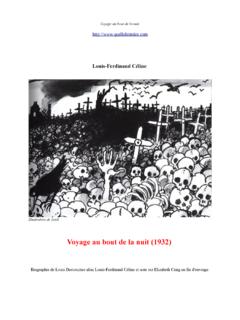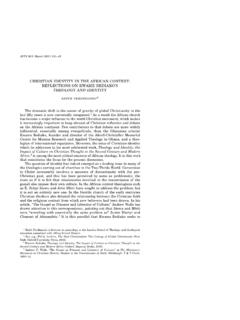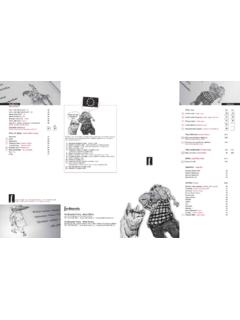Transcription of The Story of the Bull Who Wouldn’t Fight: …
1 ferdinand The bull The Story of the bull Who wouldn t fight : Resource Guide for Teachers on Non-Violent Conflict Resolution This page is intentionally left blank for double sided printing. Incorporated in 1980 as a not-for-profit company, the Hudson Vagabond Puppets creates programs designed to fit into the school curriculum as well as to entertain children and their families. Our performers are professional dancers and actors. Clad in black, the puppeteers borrow from the traditional Japanese Bunraku style of puppetry, becoming mere shadows of the larger-than-life figures they bring to life. HVP tours nationally throughout the year and has performed in concert halls, theaters, colleges, and major performing arts centers, including Avery Fischer Hall in Lincoln Center, The California Institute of Technology, Brooklyn College Performing Arts Center, and the Luther Burbank Center.
2 Narrated ballets are a specialty of the company. Our puppets have danced with symphony orchestras including The Little Orchestra Society at Avery Fischer Hall, the Phoenix Arizona Symphony, the Wheeling W. Va. Symphony (conducted by Rachel Warby), the St Louis Symphony, the Detroit Symphony, and the United States Military Concert Band at Eisenhower Hall at West Point. For more information about the company or to give us feedback on our study guide, visit us on the MUNRO LEAF (Author), author and illustrator of dozens of children's books, is best remembered for his signature character; ferdinand , the bull who preferred smelling flowers to fighting in a ring in Spain.
3 One Sunday afternoon in 1935, Leaf decided to write a children's Story so that his close friend Robert Lawson (a relatively unknown illustrator) could show his talents. In less than one hour, Leaf composed the beloved 800-word Story as it stands today, nearly 60 years later. When published by Viking in 1936 as The Story of ferdinand , the book sparked controversy. With the Spanish Civil War waging, political critics charged it was a satirical attack on aggression. In Germany, Hitler ordered the book burned, while fellow dictator Stalin granted it privileged status as the only non-communist children's book allowed in Poland.
4 India's spiritual leader Ghandi called it his favorite book. That same year, Leaf published his second most popular book, Manners Can Be Fun, illustrated with the notorious "watchbird" stick figures who observe the behavior of boys and girls. Since Leaf's death in 1976 at age 71, ferdinand has continued to charm children worldwide as the simple Story is retold in more than 60 languages. by Dianne Burch excerpt from the Inaugural Induction Ceremony Program April 22, 1995 Award bestowed posthumously Robert Lawson (Illustrator) was born in New York City, October 4, 1892, but grew up and attended public schools in Montclair, New Jersey.
5 Although as a boy he was an omnivorous reader and a devoted admirer of the fine illustrators of that time, he had no particular ambition either to write or to draw. However, chiefly due to his mother s urging, Robert Lawson entered the New York School of Fine and Applied Arts (Parsons) where he studied illustration for three years under Howard Giles. While there, he received scholarships in line drawing and illustration. His first published illustration appeared in Harper s weekly in the fall of 1914, a full page decoration for a poem on the invasion of Belgium. For many years thereafter, he did many sorts of illustration: magazine, newspaper, and commercial work, scenic design and greeting cards.
6 This was interrupted by a year and a half in the army, of which a year was spent in France with the 40th Engineers, Camouflage Section, ferdinand the bull Psychologists have come up with some intriguing techniques for addressing fighting and bullying in the schools. The Hudson Vagabond Puppets production of ferdinand the bull can serve as a focus point for an in-depth look at conflict resolution in the classroom. The performance will end with a brief lecture-demonstration developed in conjunction with ENACT, a not-for-profit organization that teaches social skills to young people (see the last page of studyguide).
7 Bullyproofing How to Use This Study Guide: Prepare the students with some of the techniques and activities introduced in the pages that follow. Use our reading guide to find additional ways to approach the subject. After the performance, discuss the techniques ferdinand used to deal with the Matador in the bullfight, and ask students to write on the subject or create performances of the Story in the classroom. HVP would like to recognize Heather O Donnell, School Psychologist at Tappan Zee Elementary, for her invaluable contributions and expertise; Christina Briggs and Ali Kenner for research and compiling this guide; and Dr.
8 Elizabeth Morano for her research and advice. All drawings are by Robert Lawsen and used with permission by Penguin Putnam. Acknowledgements: Definitions: Acknowledgement: Expression of recognition or realization. Letting someone know that you have heard and understand them. Aggression: Any behavior intended to harm another person, either physically or emotionally. It is not an emotion, but is an expression of an emotion. The intention to harm is what distinguishes being aggressive from being assertive. Alternatives: Your set of choices in a situation Assertive: Letting others know your feelings in a positive way.
9 Bully: A person who acts aggressively. This may include: teasing, taunting, threatening, hitting, stealing, isolating a peer, or spreading rumors. Conflict: A struggle between two opposing forces, ideas, or plans of action. Conflicts can be with other people Can be within yourself Can be between other people you may not even know Compromise: An agreement in which two or more sides make adjustments to reach a solution. Impulse: An immediate urge to act. If you think about your impulses and consider the consequences, you can use them in a positive way. Negotiation: A shared discussion on a topic for the purpose of reaching an agreement.
10 Moderator: A neutral person who helps in a negotiation. Peace: Harmony in human relations. Resolution: A solution to a conflict or problem. (A resolution may be a permanent solution to a situation or one that allows for more discussion later on.) Responsibility: Being accountable. Taking credit for your actions whether they are right or wrong. Victim: A person who suffers from an act of aggression. There are things victims can do to prevent bullying, including: learning to be assertive and using a support system. Witness: A person who sees an event. Witnesses of aggressive behavior must decide how to respond to what they have seen.






